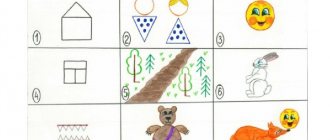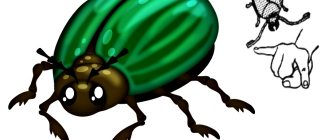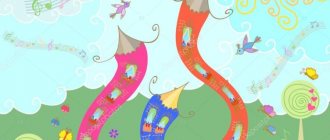Fox
A fairy tale is a small miracle, Life in the world is boring without it, Even when we are adults, We will not be able to forget the fairy tale. There are many different fairy tales on the planet, There is kindness and beauty in them, Children rejoice in wise fairy tales, Dreams always come true in them!
Yes, many interesting fairy tales have been written. And even more unwritten fairy tales - good, kind, smart. On this page you will find fairy tales invented by little storytellers - children of preschool and primary school age. About whom? Of course, about animals. About what? About the most important things: about friendship, about kindness, about mutual assistance.
The children of my senior group (MK Preschool Educational Institution Pavlovsk kindergarten No. 8, Voronezh region) wrote (with a little help from me and their parents) several fairy tales, which we combined into the collection “Autumn Tales of the Magic Forest.”
The children also came up with fairy-tale characters themselves and made illustrations for their fairy tales.
Autumn Tales of the Magic Forest
Saying or Let's get acquainted.
In one small Magic Forest there lived an old man named Lesovichok. He was very kind and wise. Lesovichok helped all forest dwellers. And there were a lot of them in the forest: Tortila the turtle, Thorn the hedgehog, Mrs. Katie the snake, Honey the bear, Jumpy the bunny, Owl the owl, Cutie the bird, Hitra the fox, Swan the swan. Lesovichok also made sure that people did not harm his forest: they did not litter, did not break trees, did not destroy birds’ nests, did not tear up primroses, and did not offend animals.
Authors: collective creativity of children
Berry jam
One day, Honey the Bear came to Lesovich, sad and very sad.
- What happened, Medok? - asked the old man - Why are you so sad?
— We quarreled with the cunning fox. I picked a whole basket of berries, and she ate them. And now we don’t talk to her.
"What to do? How to reconcile friends? - thought Lesovichok. He thought for a long time, but could not come up with anything. And then one day, when Lesovichok was putting things in order in the forest, he saw a whole clearing of wild berries. "Idea!" - he thought. The forest boy asked the little fox and the little bear to help him pick berries. It took them a long time to collect them. There were so many berries that the friends ate enough and collected full baskets. And then everyone drank tea with berry jam. And the rest of the forest inhabitants were invited to visit Lesovich. And so we made peace!
Authors: Sasha Kravchenko, Alina Aleksandrovna Kravchenko (Sasha’s mother)
Mrs. Katie has found a friend.
Mrs. Katie, a long pink snake, lived in a cozy hole under a snag. She wore a cute pink hat with a yellow flower and was very proud of it. Every morning Mrs. Katie crawled out of her hole and basked in the sun. She also loved to crawl on the fallen autumn leaves, because they rustled so merrily! Mrs. Katie was very kind, but no one knew about it. All forest dwellers were afraid of the snake and avoided its hole. This upset Mrs. Katie, because she so wanted to have a real friend!
And then one day, when Katie, as usual, was basking alone in the sun, she suddenly heard someone crying pitifully. The snake quickly crawled to where the crying was coming from, and suddenly saw that the cunning fox had fallen into a deep hole. She could not get out and cried bitterly.
“Don’t cry,” the snake shouted to the frightened fox, “Now I’ll get you out!” Mrs. Katie lowered her long tail into the hole. “Hold on tight to my tail,” she shouted to the fox. The cunning fox grabbed the snake by the tail, and it crawled. It was difficult for the snake because the fox was very heavy. But Katie coped with this difficult task. Since then, the snake Katie and the fox Khitra have become fast friends. Now they were happily rustling the autumn leaves together and basking in the sun.
Authors: Arina Plotnikova, S. N. Plotnikova (Arina’s mother)
How the little bear became polite
In the thickest part of the forest, in a den, lived a bear cub named Medok. He had a terrible sweet tooth! But most of all he loved honey. For this, the bear cub was nicknamed Medkom. One day, when the little bear had run out of honey, he went to the wild bees who lived in a large hive on a tree. The honey climbed up the tree, looked into the hive, then stuck his paw there and scooped up a whole handful of honey. The bees got angry at him, and let's bite the impudent thief! The bear cub started to run as fast as he could, but the bees were faster. They caught up with Medok and started biting him, saying: “Don’t take someone else’s!” Medok returned to the den empty-handed. The little bear thought and decided that he should go for honey when the bees were not at home. He waited until the bees flew to the clearing to collect nectar and climbed into the hive. Honey did not even suspect that there were guard bees left in the hive, who immediately rushed to the sweet tooth. The bear cub barely carried his feet away.
Honey sits on a tree stump and cries.
- Why are you crying? - asked Lesovichok, who was passing by.
“I wanted to take honey from the bees, but they don’t give it back, they just bite.” Do you know how painful it is!
- Take? Without asking? Now I understand why the bees were angry with you. Next time, just ask them for honey, but you have to ask very politely. And don’t forget about the magic word “please.” The next day Medok went to the hive again. He was very afraid that the bees would bite him again, but gathering all his courage, he asked as politely as he could: “Dear bees, please give me a little of your delicious honey.” And then a miracle happened: the bees did not attack the bear cub, but flew into the hive and flew out with a large deck of honey! “Please, help yourself!” — the happy bees buzzed. Since then, the little bear has never forgotten to say the magic word “please”!
Authors: Maxim Gusakov, N. N. Reshetnikova (educator)
Tea party
Once upon a time there lived in the forest a little bunny named Jumpy. One day he thought: “I’m tired of eating this grass! I'll go and look for something tasty. It would be nice to find a sweet carrot!” The bunny smiled, remembering how she herself prepared carrot salad for him in the morning and licked his lips. At the edge of the forest where the bunny lived, carrots did not grow, and Jumpy went in search of them in the thicket of the forest. There were such large trees here that the sun's rays had difficulty breaking through the branches. The little jumper became scared, he even wanted to cry. And then he saw someone's den. The bear cub Medok came out of the den and asked the bunny:
- How are you, buddy? What are you doing so far from home?
“I’m looking for a carrot,” answered Jumpy.
- What are you saying, buddy, carrots don’t grow in the forest.
- It’s a pity, but I really want something sweet.
- It doesn’t matter, I have a whole deck of fragrant sweet honey. Come visit me and drink tea with honey.
The bunny agreed with pleasure. And after the tea party, the little bear accompanied Jumpy all the way to the house so that the bunny wouldn’t be scared!
Authors: Matvey Blinovskov, N. N. Reshetnikova (educator)
Prickly defender.
A gray hedgehog, Thorn, lived in a hole under a large stump. They called him that because he had terribly sharp needles. Just real thorns! Because of them, no one wanted to play with the hedgehog: everyone was afraid of pricking themselves.
One day, an angry, hungry wolf appeared in the Magic Forest. He saw the Bunny Bunny and began to carefully creep up to him. This was noticed by a hedgehog who was sitting on a stump and feeling sad. The hedgehog immediately curled up into a ball and rolled right under the wolf's feet. The wolf yelped in pain and jumped to the side. The hedgehog rolled after the wolf. He stabbed the wolf with his sharp needles again and again until he ran away from their Magic Forest.
“It’s so good that you have such sharp needles,” said the Little Bunny, who came up to thank the hedgehog. “If it weren’t for you and your thorns, a wolf would have eaten me.”
All the forest inhabitants were glad that the hedgehog saved Jumpy. And Lesovichok asked the hedgehog to become a protector of the forest inhabitants and protect everyone from the evil wolf. And the wolf, remembering the sharp needles of the hedgehog, never appeared in the Magic Forest again.
Authors: Kolodyazhny Denis, Reshetnikova N. N. (educator)
Owl
An owl, Sovushka, lived in the Magic Forest. She was very young, so not very wise. One day, she woke up and saw that wild ducks were getting ready to fly away somewhere.
The owl was very surprised.
-Where are they going to fly? – Sovushka asked Lesovich.
“It’s time for wild ducks to fly to warmer lands,” Lesovichok answered her. “It’s warm there and there’s plenty of food for them.”
- Wow! I need to fly there too, since it’s so good!
The owl asked the ducks to take her into their flock. The ducks agreed. The next morning, the ducks waited a long time for the owl, but she never came. Without waiting for Owl, they flew away without her. It turns out that Sovushka overslept. After all, owls are nocturnal birds: they wake up at night, go to bed in the morning and sleep until the evening. So the Owl remained to spend the winter in the Magic Forest! But she had a good time here too!
Authors: Kolya Pashchenko, N. N. Reshetnikova (educator)
Turtle Tortila and her friends.
Tortila the turtle lived on the shore of a forest pond. Every day she slowly crawled along the shore, and when she got scared or wanted to sleep, she pulled her little head and paws into her shell. The turtle's life was boring and monotonous. She had no friends and felt very lonely. One day, early in the morning, a turtle, warming itself under the rays of the sun, lay on the shore and a ringing song could be heard from far away: The sun has risen, have fun! Morning has come, cheer up! The bunny woke up and had fun! Smiled at everyone and had fun!
Soon the gray bunny, Jumpy, ran up to the turtle and greeted her with the words: “Good morning!” -Kind! she answered him. - What a funny song you have! - Do you want us to sing it together? And they sang loudly:
The sun has risen, have fun! Morning has come, cheer up! We've already woken up and are having fun! Everyone smiled and had fun!
The hedgehog, Thorn, who was picking mushrooms, heard a cheerful song and hurried to the forest pond. - Hello, greeted Tortilla Thorn and Jumpy. - What a funny song you have! Can I sing it with you? - Certainly! The three of us will have more fun! And they sang together:
The sun has risen, have fun! Morning has come, cheer up! We've already woken up and are having fun! Everyone smiled and had fun!
To their cheerful song, the swan Swan swam to the shore. - What a friendly company you have and a funny song! he said. “Let’s all sing together,” suggested Jumpy. Suddenly, everyone heard someone crying under a bush. Everyone hurried there and saw the little bird Cutie. - Why are you crying so bitterly? - Tortila asked her. “I’m in trouble,” she answered. The wind rose and I accidentally fell out of the nest. I don’t know how to fly yet, and I don’t know how to get back. - Sit on my wing, and I will take you to your nest. The cutie did just that. The little swan took off and delivered the chick to its place. Cutie Swan thanked her and waved her wing. And all the friends sang their favorite song:
The sun has risen, have fun! Morning has come, cheer up! We've already woken up and are having fun! Everyone smiled and had fun! Together we will be friends, give happiness, joy, kindness!
The turtle was very glad that she had so many wonderful friends. The time spent with them was the most wonderful time for her.
Authors: Gulyaev Makar, Gulyaeva L. A. (Makar’s mother)
I couldn’t resist and composed a fairy tale about the bird Cutie. True, the idea for the plot was suggested to me by my children.
Sore throat
In the Magic Forest there grew a big old tree. On one of the branches of this tree there was a small nest made of feathers and blades of grass. A bird called Cutie lived in this nest. Cutie woke up early: earlier than all the forest inhabitants and began to sing her cheerful song. Every morning, Cutie flew over the Magic Forest and sang so loudly and joyfully that all the forest inhabitants were in high spirits. The songs of this little bird made everyone feel good and joyful in their souls, and this made everyone kinder.
One day, one gloomy autumn morning, the forest inhabitants woke up and could not understand anything - why were they so sad and dreary? The rain that started to drizzle only ruined everyone's mood even more. The forest inhabitants crawled out of their dens and holes, from under snags and stones, gloomy and unfriendly. "What's happened? Why are both me and my friends in such a bad mood today?” - thought Lesovichok. He began to look closely, listen, and then he understood everything: today he had not heard Cutie’s song. What could have happened to her? To find out, Lesovichok went to a big old tree where a little songbird lived.
"Cutie!" - Lesovichok called the bird. A bird dozing in a nest flew up to him. She sat on Levovichka’s shoulder and in a quiet, hoarse voice told her what had happened to her and why she didn’t sing that morning.
The cutie woke up earlier than usual and was about to sing when she suddenly saw a spring. The water there was so clear and fresh! And how beautifully the water droplets sparkled, shimmering with different colors in the sun’s rays. The cutie immediately wanted to drink this clean water. She flew up to the spring and began to drink in small sips. The water in the spring turned out to be very cold, simply icy. The cutie understood that she couldn’t drink cold water, but the water was very tasty. She drank and drank. “Well, I got drunk, now it’s time to sing my morning song, to which the Magic Forest and all its inhabitants wake up!” The little songbird opened her beak to sing loudly and tenderly, but instead a rough hoarse cry was heard from her throat. And then Cutie felt how much her throat hurt!
Now she couldn't sing.
"What to do? How can I help Cutie?” - thought Lesovichok. A woodpecker lived on a large pine tree, and Lesovichok went to him.
— Dear woodpecker, they call you “forest doctor.” Maybe you can cure our Cutie's throat?
- No, I only treat trees: I rid them of insects and larvae. And you can cure Cutie yourself. Everything you need for this is in your forest. Ask wild bees for honey. It will relieve sore throat. Raspberries grow near the lake. It will lower the temperature. And at the edge of the forest the rose hips had already ripened. It will help the patient get stronger and gain strength.
The forest boy thanked the woodpecker and went to the clearing where the forest inhabitants had already gathered. Lesovichok told his friends everything and they decided to help: the bear cub went to the wild bees to ask for some honey, the fox picked raspberries, the little hare and the hedgehog picked a whole basket of rose hips, from which Lesovichok cooked a healing decoction, the swan Swan gave some feathers to warm up Cutie, and the turtle Tortilla volunteered to take all this to Cutie. But everyone politely refused her offer: after all, everyone knows how slowly a turtle moves, and Cutie needed help urgently! Lesovichok carried everything himself and soon Cutie recovered. She could sing again. And her songs were even better and louder, because she sang for friends who did not leave her in trouble.
We really hope that you liked our fairy tales. And if you want to write a fairy tale about animals, that would be great!
Send it to us and you will definitely see it on our website!
Secret 2: how to teach a child to tell his own fairy tale?
After creative planning - coming up with the plot of a fairy tale, start telling the fairy tale with your baby.
If the child is still small (3-4 years), then start the phrase, and the baby will finish it. It will look something like this: “Once upon a time there was... who? (child is a “leaf”). And he lived on... (the child finishes). It has arrived... A strong wind blew. One day the wind... The leaf got scared... He asked... Rowan answered... And he flew....” etc.
By setting the beginnings of phrases, you help your child build connections between sentences and parts of the text. Such co-creation is very useful for a child, because in it the child accumulates a kind of “dictionary” of connectives and fairy-tale words (once upon a time, suddenly, one day, asked, said, answered, surprised, began, and they began, etc.). Often writing fairy tales with your mother and “absorbing” this experience, after a while a turning point will occur: you will suddenly notice that the baby has begun to actively use fairy tale words and connectives in his speech, in his writings without your help, he easily constructs the text and does not stutters between sentences, he has smooth, rich, expressive speech! This is exactly the result we are striving for!
If the child is 5-6 years old , then your help will depend on the level of speech development of the baby and his individual characteristics. Some children do not need help, others need to be given the beginnings of phrases as at 3-4 years old, for others a prompt question is enough: “What happened next? Who did he meet? What did you say?"
The technique of dictating a fairy tale to an adult.
I highly recommend recording the resulting fairy tale from your child’s dictation. This technique of “dictation” by a child to an adult develops speech in a way that no other technique can develop it. And the point here is that the baby is put in a situation where he has to dictate, which means he has to think through his speech and every word he says! With this technique we are preparing the transition from oral to written speech! When a child dictates, he constructs sentences that he would not be able to construct in another situation! That is, dictation of text is like a “bar” for growth for a baby!
If the baby repeats the same word many times, then you can correct it: “Listen, how we did it. The leaf said: “Hello,” Rowan said: “Hello.” The leaf said: “Who are you?” And the rowan said: “I am the rowan. And who are you? You and I repeat the same word “said” all the time. Let's try to replace it. How can you say it differently? (together with the baby, choose the words - whispered, said, exclaimed, answered, asked, was surprised).” By using the technique of your child dictating your fairy tale, you will not only enrich your child’s vocabulary and develop coherent speech, but will also make a significant contribution to the successful preparation of your child for school.
The redhead hits the road
A fairy tale about animals, invented by children, should also have an instructive component. The Fox was surprised by Owl's advice. I thought about it and decided to obey: who wants to while away their life in girls! So she packed her knapsack, combed her fluffy red fur coat, put on her morocco boots and set off for distant lands. She walked past a distant lake, a forest, and a neighboring village. Behind that village the forest was completely dark. She sees a bast hut standing on the edge of the forest, decorated with paints and flowers. She knocked on the door - no one answered. Then the redhead began to knock even louder, until a voice was heard from the hut: “Who is bothering me there with their noise?” “It’s me, the red-haired gossip, coming from distant lands, looking for shelter for the night. Whoever lets me in for the night, I’ll sell him a good product, a rare one – a chicken of a special breed.”
Entry Fourth... and the last one this time.
You are confusing, Purity of the Unopened Leaf...
Many of us have a fear of the “blank page”... That is why even many genius writers write on unimaginable scraps of paper - on napkins, receipts...
To overcome this fear, the sheet needs to be stained... with scribbles. That is why, by the way, the drafts of many geniuses are full of drawings in the margins.
Place your pen on a blank sheet of paper and begin to draw intricate lines, shading the sheet, as very little children do.
At some point, your hand will want to stop on its own. Look at this "drawing". Try to see something meaningful in it. Write down any associations that arise.
Now (without stopping!) start writing coherent sentences about these associations.
Sunset Third
The third pass is a little more advanced than the first two. It requires visualization. Take the word that catches you most - from those ten words you chose at random...
Imagine the object that this word denotes. Imagine this object in its natural context, live the life of this thing. Draw, in short, a picture inside your imagination. Did you draw it? Well, now - turn the course of natural events in this picture sharply by 180 degrees! That is: imagine what could BREAK this picture... This is a conflict, and this conflict will be the basis of your fairy tale.
For example, I imagine a desk work lamp illuminating a desk with manuscripts scattered across it. And suddenly... The lamp goes out. The room is filled with darkness. What was it? This is the beginning of my unwritten fairy tale...
Sketch out a dozen of these ties. These will be your working preparations for fairy tale therapy... On other days, return to them, re-read them, correct them, make changes... Add new ones to them.
And one fine day one of the plots will wink at you, and you sit down to continue it - the fairy tale will write itself. And the rest of the preparations - they will go into action, continuing the plot you have already started.
Sunset Second
If games with words do not impress you (because you are in an excited stressful state, for example), then the following technique will help you write your fairy tale. Think about it: what topic would you be interested in talking about right now?
Let the “working” theme of the fairy tale be the problem that you have been scrolling through in your head lately. No money? Doesn't your loved one call? Years go by? Children don't listen?
Once you start writing a story about a topic that is important to you, you may suddenly discover new ways to make money, a new perspective on your relationship with your loved one, and a new perspective on your relationship with your children...
All your worries and sorrows can (and should!) become the theme of your psychotherapeutic fairy tale!
How the Fox was fooled
Then the gate opened, and the owner of the bast hut, the Fox, came out. “Why, redhead, are you lost in the forest? Why didn’t you spend the night at home?” The fox answers: “I went hunting, but I hesitated in catching a purebred guinea fowl. Now it’s too late for me to return home. If you let me into the yard, I’ll sell you my loot at a good price.” “And what will your price be, gossip?” “For ten gold pieces I’ll give you the whole thing, plus a cabbage leaf,” answered the Fox. “Okay, then come in,” answered the Fox. The redhead went into the bast hut, where the stove was just flooded. And she was so exhausted that she fell asleep right there on the bench.
In the morning the Fox woke up, and meanwhile the Fox was taking care of the housework and getting ready to hunt. “What is the owl science here?” — the redhead began to think. And the Fox says to her: “Well, if you’ve had enough sleep, godfather, then drink milk from the jug to the bottom. And pack your knapsack and leave the hut already - it’s time for me to go hunting.” “What about the chicken?” - asked the Fox. “And keep your prey for yourself, you see, I am a noble Fox, always ready to shelter a wanderer.”
The fox went home. Look along the road - there is no guinea fowl in her knapsack. There are no morocco boots either - she has birch bark sandals on her feet. The deceived gossip said to herself: “Why did I have to deal with this Fox?” It was then that she remembered the words of the wise Owl, and the Fox began to work on correcting her character.
And finally...
Once again I want to draw the attention of all readers: do not try to write a fairy tale that looks like a small, polished literary masterpiece! Write quickly, without thinking about either the logic of the development of events or the “character development” of the characters.
You are writing a psychotherapeutic text!
His tactical goal is to be written down!
Its strategic goal is to make you healthy physically and mentally!
Before elegant stories (perhaps) begin to emerge from your pen, you will need to spew out “thousands of tons of verbal ore” from your unconscious. And every such evil, bad, clumsy fairy tale will be an important step that will bring you closer to a cure for chronic stress and confusion in your head.
And now we suggest playing several games with psychological cards and testing your abilities in writing fairy tales.
Exercise No. 1 “Ten words and phrases”
Write ten words on a piece of paper - ten common nouns, maybe phrases (table, chair, lamp, window, tin can, sweet peas...) And now write a story using all these ten words and linking them together in meaning.
WHERE DO I GET TEN WORDS FROM?
And here’s where it comes from – from one random card of the “1000 Roads” deck! Look at it and take words and phrases from there.
PROHIBITIONS IN THE GAME:
- You cannot take words from the TEXT of the card, only from the PICTURE!!!
You can’t compose a “story based on a map” - you can only take images from it for your own, OTHER story, about something completely, completely different. For example, the card “Country Fair”, and you have a story about a spaceship on Mars. It’s more interesting, more creative. Anyone who did not understand and made up a story based on the card is disqualified as a player!!!
RULES OF THE GAME:
- two players receive the same card,
everyone chooses their 10 words from the picture of the card (silently),
silently writes them down on a piece of paper,
and then everyone silently sits down to write - their own short fairy tale on the same card as their partner,
time – 7 minutes.
fairy tales are not signed with the player's name,
At the end of the work, both fairy tales are read by the Presenter - to the public - without explanation - which fairy tale was written by Masha, which by Marina.
The Anonymous Fairy Tale, which wins the Audience Award, is awarded a real gift. Its Author too.
At the end of the game, a sharing analysis is held with the performance of each voter - why did you like one fairy tale more and the second less...
those who act out their fairy tale themselves become members of the voting jury and picky listeners (so that the losers are not offended).
Exercise No. 2 “What could disrupt this picture?”
“Two teams” play again. Only now there is only one player on one team, and all the other training participants on the second team.
One Player (Customer of the brainstorm) chooses consciously (but spontaneously if he wants) one card from the deck of 1000 Roads. (It will definitely be somehow connected with his real problems).
The Customer Player looks at the picture and worsens it - turning the course of natural events in this picture sharply by 180 degrees! That is, it creates a Conflict or Problem.
Usually this is done by taking a “good card” and “making it worse.”
For example:
– I imagine a desk work lamp illuminating a table with manuscripts. Suddenly the lamp goes out. The room is dark. What is this? What to do? This is the beginning...
The rest of the players (team) must solve the problem positively.
Therefore, they all together draw another spontaneous card “1000 Roads” as an answer to the question asked by the customer - what to do in such a situation and what was it all about...
Then, silently, each player of the second team writes HIS OWN Option - answer, advice and help.
So, using two identical “1000 Roads” cards, each player composes HIS OWN Story-Recipe. Operating time – 10 minutes.
The presenter collects the leaves from the second team and reads out all the healing fairy tales in turn, without naming their authors.
The Customer Player selects and awards the 3 best (in his opinion) fairy tales. If there are few players (5 or fewer people), only one best tale is awarded.
Elena Nazarenko
Today we have completely forgotten the wonderful word “boiling water”. It somehow completely disappeared from our daily vocabulary. And what this word means has seemingly disappeared even from our everyday life!
Let's talk about the most important factor of Success - Faith
Today, almost all of us suffer from one cunning “psychological disease”. It's called "Lack of Self-Acceptance." More specifically, we don’t feel what we...
Fairytale therapy and theory of fairy tales, types of fairy tales in world culture, understanding of tragedy for psychotherapeutic work with fairy tales
We decided to compile the most detailed list of benefits received from financial self-education and development of investment skills. I would like to believe that in this list everyone will find that decisive argument...
How to fill a “children’s piggy bank of memories. Pedagogy - and prevention of adult depression according to Goethe. Goethe the psychologist - to the collection of parents and those adults who believe that changing their w...
Popular articles
Music therapy is one of the areas of art therapy. Listening to classical music during depression, neurotic anxiety, and aggression relieves negative emotions.
The “Letter of Gratitude to the Universe” technique can make us truly invulnerable, but for this it must be turned into a habit.
The games that I have collected in this article do not require any complex stimulus materials or knowledge of techniques. They are specially designed for parents working with their children at home - in…
We forget that the most important “magic” word is THANK YOU. And we need to say it not when we were given a Mercedes, but always!
Archetype "Well"
The well is, of course, an archetype. Who could argue with that? But we often understand it incorrectly. Why? Because any archetype needs to be explored where it manifests itself in all its...
"There are no worthy men"
This psychological material is dedicated to debunking the popular myth that there are no worthy men and other similarly structured myths that distract a person from the feat of self-improvement...
You may or may not believe in affirmations, but they work even when you don’t practice them or say them. How so? Let's figure it out
In the textbooks on literary reading of some teaching materials for grades 2-3, there are tasks to compose a fairy tale or story on your own. In fact, this is not difficult to do, you just need to grasp the idea. Often it is given not just to compose a fairy tale, but a fairy tale on a specific topic, for example, its meaning should be some kind of proverb. The program contains the planet of knowledge, for example: “tackle a good deed skillfully” or others of your choice.
Secret 4. How to make a homemade book with a children's fairy tale?
I always put children's fairy tales into homemade books. I fold the album sheet in half. It turns out to be a “book” of 4 pages. The first page is the cover. A child draws it. On the cover we sign the name of our fairy tale. We make sure to choose a title that makes it clear what the fairy tale is about. The next three pages are the fairy tale itself: its beginning (second page), middle (third page) and end (fourth page). I write the text at the bottom of the page from dictation. And the child draws pictures.
The child quickly forgets his actions, especially his words. Speech is generally a phenomenon that cannot be touched, stroked or felt in any way. Such books show the child the visual result of his speech, his efforts and arouse great interest among all children. After all, this result is beautiful, you can show it to a friend, dad, grandma, stroke it, touch it!
Honestly, I have not seen a single small child who would refuse to compose a fairy tale and publish his own book based on it, in which he will be both an artist and a writer. Moreover, even the most active and hyperactive preschoolers are ready to engage in this exciting activity for hours!





